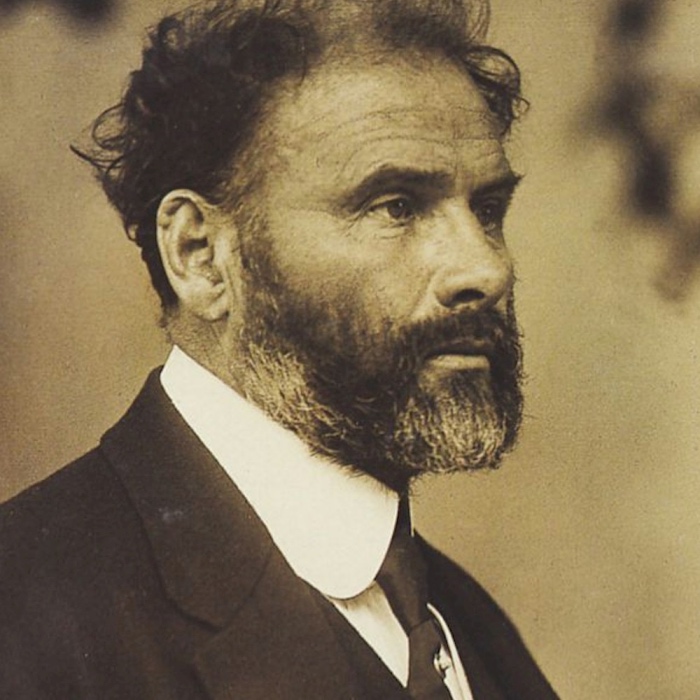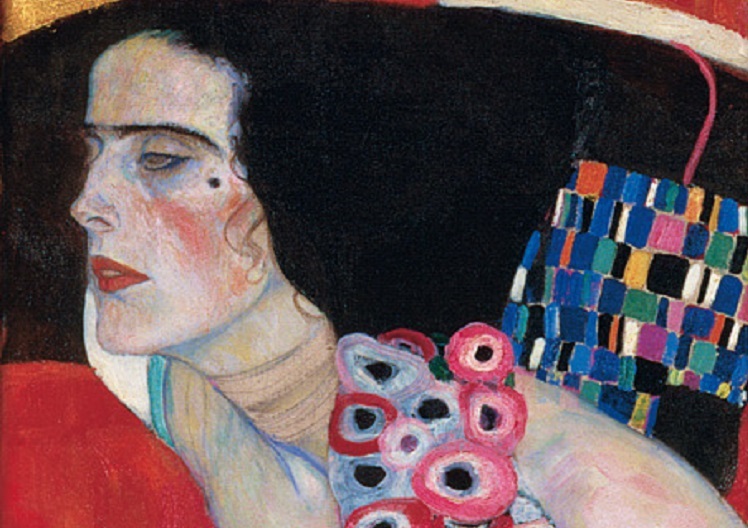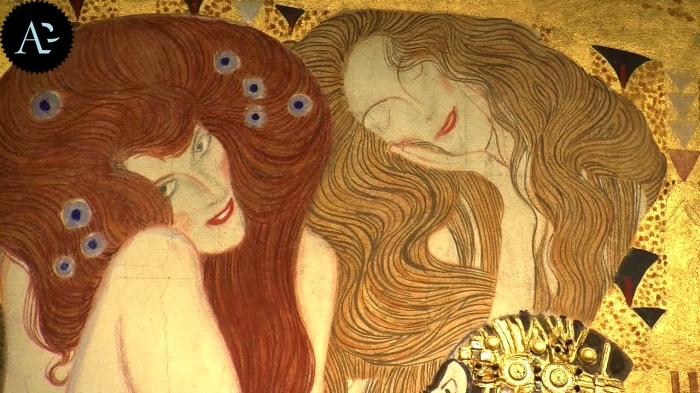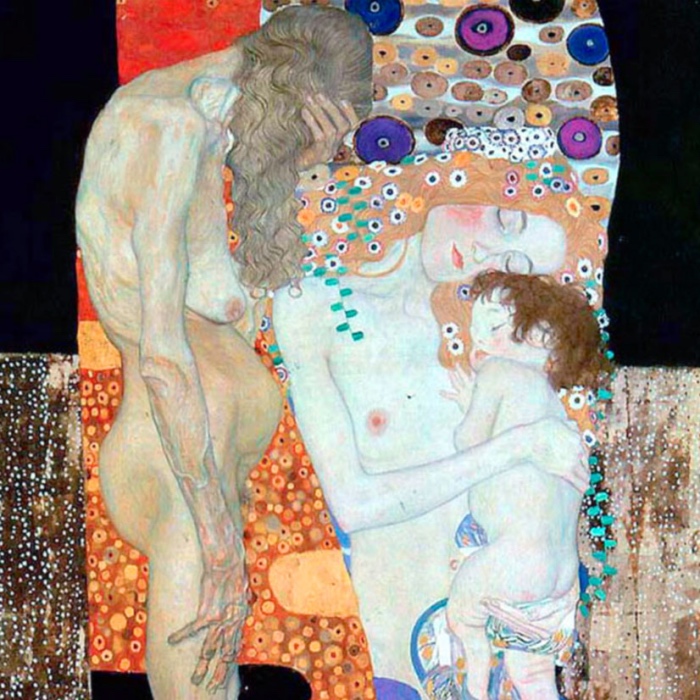
5 THINGS TO KNOW ABOUT GUSTAV KLIMT
Gustav Klimt was the protagonist of the Vienna Secession movement, and the driving force of a renewal of European art.
He painted fascinating society women wrapped in thick decorations, but he was also the author of bright mosaics and majestic allegories.
5 things to know about Gustav Klimt

Klimt, Salomè – Museo Ca’ Pesaro, Venezia (dettaglio)
1. WHEN GUSTAV KLIMT WAS BORN
Gustav Klimt was born in Baumgarten, near Vienna, in 1864 where he spent his quiet but poor childhood.
His father was a goldsmith and Gustav learnt from him the art of precious metals manufacturing.
At the age of 15 Gustav was admitted at the School of Art and Craft of the Austrian Museum of Applied Arts, where he stood out in each subject, but especially he emerged as a capable painter and portrait painter.
READ ALSO – Where you can admire the Kiss by Klimt
2. KLIMT AND THE “COMPANY OF ARTISTS”
Gustav Klimt created along with his brother Ernst and his friend Franz Matsch the “Company of Artists”.
It was an artistic and professional association, which allowed those artists to obtain important commissions, such as the decorations in the Burgtheater and in the Kunsthistorisches Museum in Vienna.
In addition, the association allow Klimt to obtain his first recognitions.
In 1890, in fact, he received the Emperor award for a painting representing the stalls area of the old Burgtheatre crowded with 130 faithful portraits of well-known contemporary celebrities.

Klimt, il Fregio di Beethoven (dettaglio)
3. KLIMT AND THE “VIENNA SECESSION”
After his brother Ernst died in 1892, Gustav went into a deep depression and that event caused the end of the “Company of Artists”.
Gustav Klimt began thinking his artistic experience over and approached a group of artists who rejected from the Academy of Fine Arts, in order to form an autonomous group with its own site, the “Vienna Secession”.
4. GUSTAV KLIMT AND THE GOLDEN PHASE
Klimt became one of the founding members and president of the “Vienna Secession”.
The aims of the group were a complete fusion of arts, going beyond Academic compositions and renovating art.
For the 14th“Vienna Secession” exhibition Klimt painted the “Beethoven Frieze” directly on 3 walls of a room.
This work launched the “golden phase”.
In that period Klimt’s works were characterised by the use of gold, decorative symbols and line and stylized figures.
5. KLIMT IN VENICE
As a result of the crisis of the “Vienna Secession”, Klimt came close to the WienerWerkstatte (Vienna Workshops) andhe wascommissioned to decorate theStoclet Palace in Brussels, and, at the same time, he was dedicated exhibitions and gained recognitions.
In 1910 Klimt took part in the 9th Venice Biennale (Biennale di Venezia), and there he was dedicated a personal exhibition.
He began his production of works that belonged to flower Klimt drew his inspiration from paintings by Matisse and from oriental decorative patterns.
Gustav Klimt died in 1918, aged 56, and his pupil Egon Schiele painted him on his deathbed.

Klimt, Le età della vita – La Galleria Nazione, Roma
READ ALSO – Famous kisses: the 5 most beautiful kisses in history of art


Un’altra cosa da sapere su Klimt.
Mi colpisce l’ultima opera del maestro Klimt, Adamo ed Eva peraltro pure incompiuta, così è sembrato a tutti… Ma questa presunta incompiutezza ha un valore immenso perché cela tutto il mistero di Gustav Klimt.
Tutti sono concordi nel ritenere Eva il vero soggetto del dipinto di “Adamo ed Eva” di Gustav Klimt, mentre Adamo è quasi nell’ombra. Ma non si conosce bene il Klimt artista se si giudica in tal modo la sua opera, non solo per questo caso.
Gustav Klimt si definiva “un povero pazzo”, ma a chi cercava di delinearne la camaleontica personalità un giorno rispose: “Chi vuole sapere di più su di me, cioè sull’artista, l’unico che vale la pena di conoscere, osservi attentamente i miei dipinti per rintracciarvi chi sono e cosa voglio”.
Ed ecco che si scopre l’arcano, perché per vederlo si osservi bene l’Adamo in secondo piano dietro Eva che impersona la sua prima moglie Lilith. E l’attenzione va riposta là dove doveva esserci la mano di lei ma anche quella di lui.
Ahimè non ci fu tempo per dipingere la possibile mano destra di Lilith stretta nella mano di Adamo, il tempo ne aveva spazzato la memoria. Ma il maestro Klimt non avrebbe mai potuto nemmeno dipingere le due mani legate fra loro perché la morte lo colse. Forse lo presagiva mentre dipingeva perché nell’intento di porre un simbolo floreale funesto su Lilith la vampira, dipinse sulla sinistra, a due terzi della coscia di lei, un papavero, che segnala l’intorpidimento dei sensi indotto dall’oppio, e simboleggia la morte.
Adamo è ritratto in un secondo piano, quello terrestre dei mortali, e mentre la sua vecchia sposa Lilith, immortale, appare sempre giovanile e luminosa di bellezza, il solcato suo volto è appesantito dal tempo. Il lavoro dei campi lo ha imbrunito e segnato nelle membra, non più giovanili, come al tempo dell’amore con Lilith e poi con Eva. Ma lui, ad occhi chiusi, sogna quei tempi nei momenti di riposo come se fosse in sintonia con la testa reclinata come quella dell’amata antica, se pur preso dal vecchio rancore del “sotto” e “sopra”. Ma ironia della sorte, il maestro Gustav lo dispone sotto di lei a soggiacere finché piacerà a lei.
Il quadro di Adamo ed Eva non è incompiuto, così andava fatto.
Ebbene è in Adamo che Klimt si riflette, l’artista in attesa per quella stretta di mano che non fu possibile concepire. Gli fu possibile un bacio rimasto memorabile, ma la mano nella mano è un’altra cosa. Ricorda il camminare insieme di due giovani innamorati appena conosciuti, svagati ma uniti, parlando e ridendo. A volte incrociando gli sguardi come in un amplesso furtivo non ancora avvenuto. Un preludio che nello scenario del dipinto, sa di morte che di lì a poco avvenne. Ed ecco l’incompiutezza rimasta nel tempo, ma che si estingue se due giovani innamorati ammirano il dipinto di Adamo ed Eva e vi si immedesimano.
Grazie per questo commento ricco di dettagli.